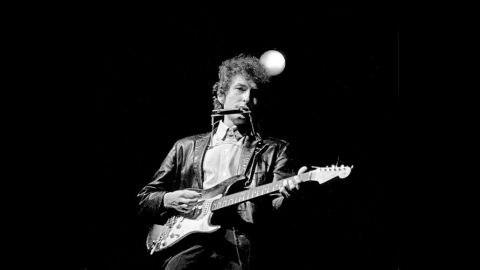Electric Apostasy: The Day Bob Dylan Died

For the 1950s generation, “the day the music died” was February 3, 1959 — the day when the plane carrying Buddy Holly, Ritchie Valens, and “The Big Bopper” crashed. For the 1960s generation, however, “the day the music died” was July 25, 1965 — the day when Bob Dylan crashed the 1965 Newport Folk Festival stage with an electric guitar in front of him and rock band behind him to rip into a loud, raucous version of his new hit, “Like a Rolling Stone.” Bob Dylan the folk figure of the early ‘60s was dead. Bob Dylan the rock voice of the late ‘60s generation was born. “For many people the story of Newport 1965 is simple,” author-musician Elijah Wald writes in Dylan Goes Electric: Newport, Seeger, Dylan, and the Night that Split the Sixties, “Bob Dylan was busy being born, and anyone who did not welcome the change was busy dying.” In Dylan Goes Electric, Wald tells an electrifying story of just how complex the true story of that moment was — a cultural crossroads now mired in mythology, but even more fascinating and significant when told with clear eyes and an understanding of both sides of the divide Dylan stood across.
Wald’s built a reputation as an iconoclastic critic of the music mythology that distorts true music history. How the Beatles Destroyed Rock ‘n’ Roll: An Alternative History of American Popular Music, Talking ‘Bout Your Mama: The Dozens, Snaps, and the Deep Roots of Rap, and Escaping the Delta: Robert Johnson and the Invention of the Blues each pulled at a thread of the tapestry of conventional music wisdom and revealed hidden depths. Andrew Grant Jackson’s 1965: The Most Revolutionary Year in Music (which I reviewed here) focused tightly on 1965 as a pivotal year, with Dylan featured as a major player, but Wald’s book slices through the myths even deeper and then telescopes out in both chronological directions — to the folk-driven, communal, social consciousness of the early 1960s and to the rock-driven, revolutionary individualism of the Woodstock late 1960s.
Before Dylan, as Wald extensively establishes, there was Pete Seeger. Before Seeger, of course, was Woody Guthrie, the man Dylan consciously copied and sought out when he came to New York City in 1961. “Seeger was a hard man to know and sometimes a hard man to like,” Wald explains, “but he was an easy man to admire, and he backed up his words and beliefs with his actions.” What separates Seeger from Guthrie, for Wald, is Seeger’s compelling vision of folk music as interactive, “pioneering a new concept of folk music as an active, living process, a matter of style, approach, and interaction between players and listeners.” While others resurrected folk music as fashionable museum pieces, Seeger saw folk music as a corrective to the conservative, racist, military-industrial complex 1950s — a way to get people first singing about change and then working toward it.
But before Dylan met Guthrie — literally on Guthrie’s deathbed — young Bobby Zimmerman of Hibbing, Minnesota, wanted to be a rock and roller. Dylan heard Buddy Holly play in Minnesota just three days before that plane crash in Iowa. Photos show the young Dylan rocking with a variety of bands at a number of talent shows and school events, all with one common theme — they were loud! Yet, when rock and roll hit the mainstream, lost its edge, and Elvis started making movies, suddenly folk music became the cutting-edge choice of the younger generation. Wald follows closely young Dylan’s formative stage, in which “everyone recall[ed] the speed with which Dylan absorbed style and shifted personas … and the only safe generalization about him at this point [was] that he was very hard to pin down.”
The most elusive element of Dylan’s protean nature consistently remained his ever-changing sense of alliances: “Sometimes he wanted to fit in, sometimes to distinguish himself.” After reading through Dylan Goes Electric, you get the sense that that night in Newport in 1965 was almost inevitable. “I played all the folk songs with a rock ’n’ roll attitude,” Dylan later recalled. Even at his folkiest, Dylan remained a rocker at heart, with a rocker’s resistance to authority of any kind, even the gentle authority of Seeger’s folk establishment enshrined annually at Newport. Hence, the “electric apostasy,” as Wald calls it, of Newport 1965. Wald insightfully reads pre-rock Dylan songs such as “Blowin’ in the Wind” as a resistance to any answers but one’s own and “Only a Pawn in Their Game” as a refusal to play a passive role in any movement, however noble, which makes that night at Newport more understandable than ever before.
Wald wonderfully sets up Seeger and Dylan as a series of contrasts representative of their specific political and musical moments in time. Seeger, a child of the Great Depression, believed in a democratic ideal in which people could band together in political struggle and overcome any obstacle through sheer numbers and sheer faith. Dylan, shaped by the post-war “Baby Boom,” rebelled against that same democratic ideal as a pipedream and rooted his faith in a rugged individualism that protested any type of conformity, even the conformity of Seeger’s political movements. Just two years before Newport 1965, Dylan, Seeger, and others joined together to sing “We Shall Overcome” as a grand finale. In just two short years, that grand gesture of solidarity became impossible.
Bob Dylan the folk figure died on July 25, 1965, but Seeger’s reputation died that night, too. As Wald points out, Dylan the rocker is more myth than reality, since Dylan disappeared for years after a serious motorcycle accident in 1966. In Wald’s phrase, Dylan’s more a “holy ghost” of the late 1960s — distantly hovering above rather than a presence in their midst. Even when Woodstock happened near his home in 1969, Dylan rumors, but never Dylan himself, floated about. Wald’s Dylan Goes Electric: Newport, Seeger, Dylan, and the Night that Split the Sixties colorfully comments on a turning point in American music, but also sheds light on the generational shift within the 1960s, which today is too often seen as a single, continuous movement. As alternative music today struggles to distinguish itself and find relevance in an iTunes universe of corporate pop, maybe we should look again to Dylan’s “holy ghost” for inspiration.
[Image: Newport 1965: Dylan goes electric at the Sunday night concert. Photo Credit:Diana Davies; Davies photos courtesy of the Ralph Rinzler Folklife Archives and Collections, Smithsonian Institution.]
[Many thanks to HarperCollins Publishers for providing me with the image above from and a review copy of Dylan Goes Electric: Newport, Seeger, Dylan, and the Night that Split the Sixtiesby Elijah Wald.]
[Please follow me on Twitter (@BobDPictureThis) and Facebook (Art Blog By Bob) for more art news and views.]





